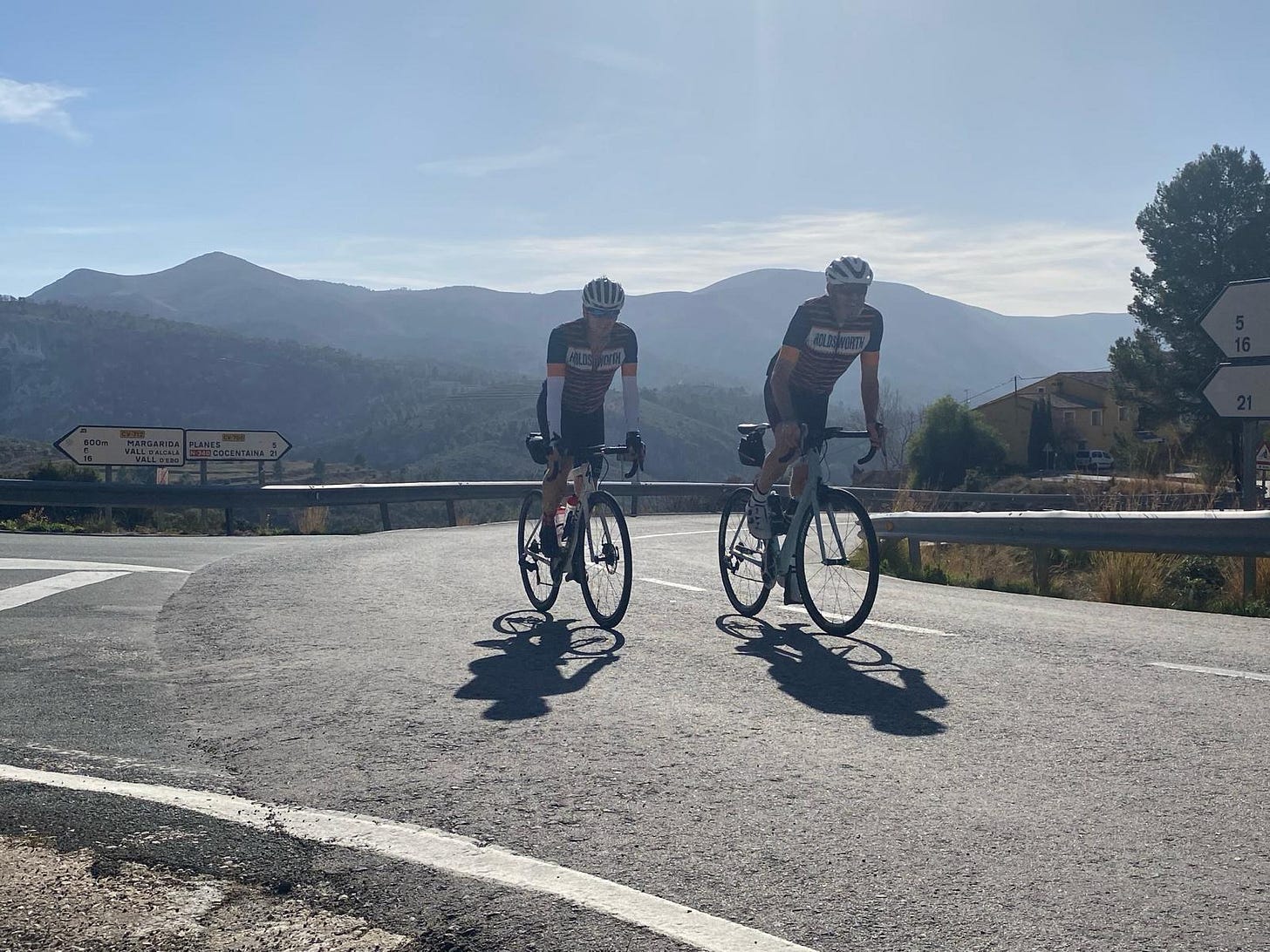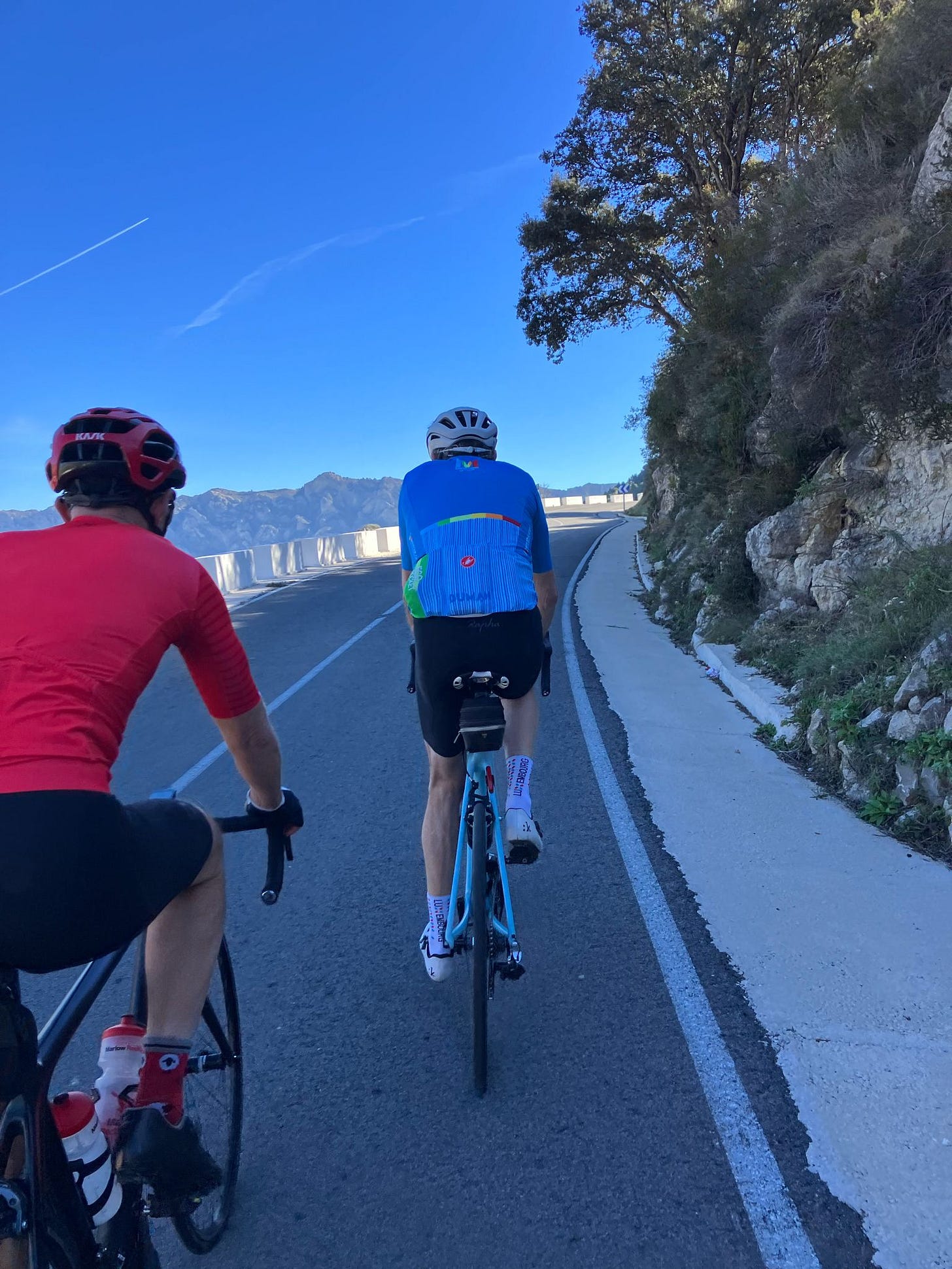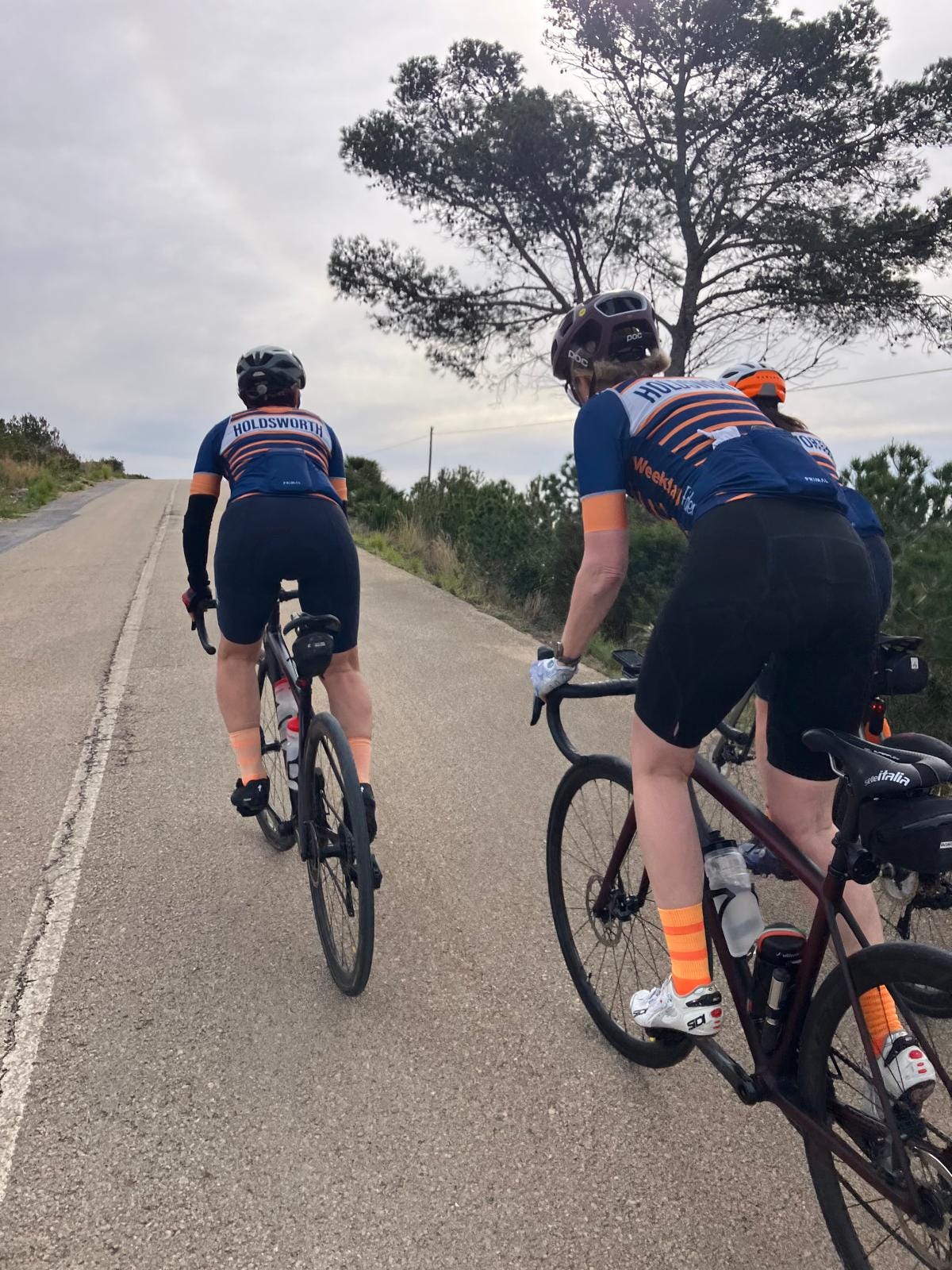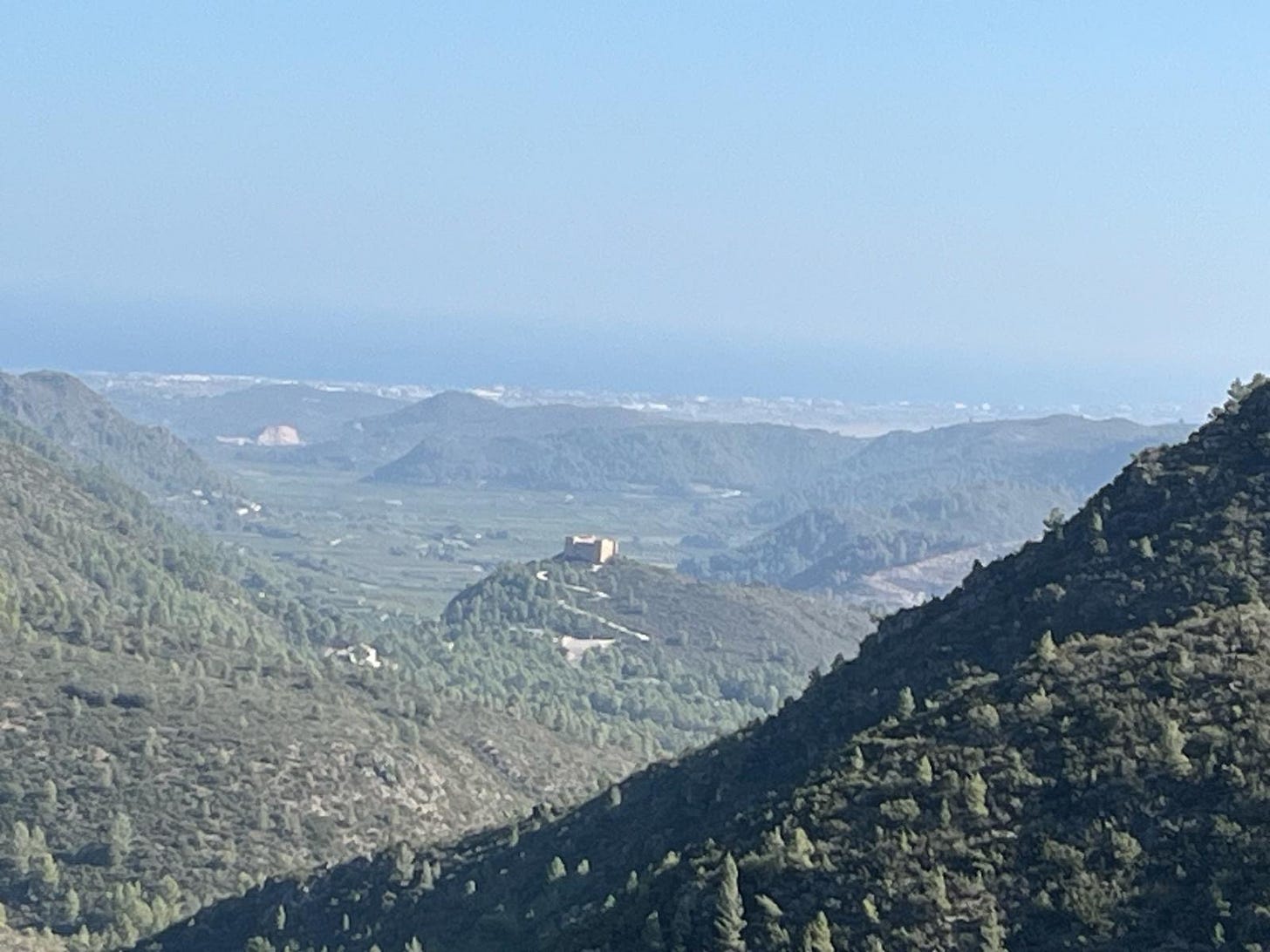As a kid, I was on a bike at every opportunity but when I outgrew my bike in my teens, it would be 15 years before I took to two wheels again, excepting the 250cc kind. With the power profile of a sprinter, climbing always felt quite challenging, and while I’d still say I’m not a natural climber, after years of learning and practice, there’s now little I love more than climbing mountains on my bike to get to some of the most beautiful places in the world. In this article, I’ll share some of the insights that help me climb with confidence and enjoyment.
Different Climbing Scenarios
Not all climbs are the same, and different situations call for different strategies. Here are two scenarios to consider:
· Local hills and general climbing confidence – If your goal is simply to feel more comfortable on the rolling climbs around our area, small adjustments to technique and pacing can make a big difference.
· Targeted training for a hilly sportive or European trip – If you’re preparing for something like one of the club’s trips to Mallorca or Denia, or a challenging sportive, you’ll want to focus on endurance, pacing, and repeatability.
Bringing in specific local examples can help with both approaches. For example:
· Aston Hill – A great climb for steady tempo efforts at a consistent cadence.
· Quarry Wood – Requires smart pacing on the initial ramp, good line choice through the tight corner (going wide toward the centre of the road will be less steep than the inside line), and settling back into a rhythm for the remainder.
· Windmill Hill or Watlington Hill – Ideal for practicing standing efforts, such as alternating 10 pedal strokes out of the saddle followed by 10 seated, helping with power over the steeper pitches.
· Pishill – A longer, steadier climb where drafting with a group can give you an advantage, both physically and mentally.
Bike and Gearing
Chances are your bike and gearing are already appropriate to where you live and the kind of cycling you do day-to-day, but if you're heading into a big challenge, consider whether you could benefit from some adjustments. It could be as simple as lowering your gearing by changing your cassette, or it could involve pricier/more complicated alterations so consult your bike mechanic if you’re not sure.
Psychology
Climbing can be mentally challenging, but a shift in perspective can make a world of difference.
Reframe: Instead of fixating on the difficulty of the climb, think about the rewards of making it to the top – spectacular views and the exhilarating descent. Check out the descending article if you're looking for some tips for getting down the other side.
Accept your pace: Overcoming the anxiety of holding others back is crucial. Recognise that the difference in climb times within a group is often marginal and if your companions are committed to the Marlow Riders ethos of "Cycling for All," they’ll more than likely be happy to wait and celebrate the achievement together.
Visualisation: Visualisation is a technique commonly employed in sports psychology. According to Predoiu et al, “[it] is powerful because the subconscious processes the experience as a real one (by firing those neurons that are responsible for skill acquisition), makes the person calmer and more adapted to stressful situations, and can speed up the learning process in athletes.” Visualising yourself climbing with good technique and relaxed, controlled breathing will help prepare you to do the same in practice.
Focus on now: If the length or gradient of a climb are inducing anxiety when you're on it, try keeping your gaze just a few metres in front of you. Occasionally look ahead to keep an eye on what's going on, but keep your brain focused on what's happening right now instead of how far you've got to go or how difficult it's going to be. Remember to stay as relaxed as possible, breathing in through the nose and emphasising long, steady and full exhalations. Try mentally encouraging yourself the way you might encourage someone else, and silently counting, singing or repeating a mantra to prevent your attention shifting to the discomfort. One of the club’s founders, Rod Woodland, was renowned for the support and encouragement he gave his fellow riders. I didn’t know Rod very well, but I believe he used to encourage struggling climbers with the mantra, "just one more pedal stroke".
Technique
Refining your technique can make a world of difference to your experience of climbing:
Gearing: Anticipate changes in gradient and shift into a lower gear before you lose momentum. When shifting from the big chainring to the small, first shift up a few gears harder on the cassette so you'll be at a similar gear ratio once you shift into your small chainring, and you won't spin out.
Cadence: Some riders prefer to grind away in a high gear at low cadence, while others prefer to spin a lower gear and higher cadence. Lower cadence is more taxing on the muscles, while higher cadence is more taxing on the aerobic system. In your day-to-day riding, it's good to practice a range of cadences, including at the extremes; that way, you'll find your happy medium, and whatever climbs and conditions you encounter, you'll also have a full arsenal of tools for the job.
Souplesse: Keep your pedalling relaxed and smooth. Focus on making a circular motion, applying consistent pressure throughout the entire pedal stroke. If you have a tendency to mash the downstroke, think about driving the pedal stroke from your knees rather than from your feet, and keep your feet light as if your cranks are made from delicate glass and you’re trying not to break them.
Efficiency: Save energy by minimising the use of muscles that are not propelling the bike forward. If you have a natural tendency to do things like bob your body when seated or wrestle the bike from side to side when out of the saddle, it might help to think about making your climbing appear effortless to an onlooker. Check out this clip of one of the best climbers in the pro peloton today, Jonas Vingegaard. When seated, virtually nothing moves except his legs, and even when attacking out of the saddle, he's just letting the bike gently sway beneath him.
Breathing: While it might not seem natural, or even possible, try breathing in through your nose at least some of the time as there are numerous potential benefits of doing so1. The nasal passages produce nitric oxide, which helps to dilate the blood vessels, improving blood flow and oxygen delivery. Breathing through the nose may also help to regulate your breathing rate, especially when coupled with long, full exhales. A controlled breathing pattern can in turn can help you stay relaxed, parasympathetic state.
Seated or standing
Various studies2,3 have analysed seated vs standing climbing positions. Seated climbing is generally regarded to be more efficient; however, there are reasons to employ both positions. Seated climbing can be more sustainable for longer climbs, as it typically allows for a more consistent and controlled power output and enables better utilisation of the pedal stroke. Standing can be beneficial for short, steep sections or accelerations, as it allows you to use body weight to generate more power. Muscles are recruited differently in the two positions, so varying between them can give some muscles time to recover while others take on more work. Varying positions can also give you a mental break as well as potentially some relief from aches and pains that may develop from extended periods in one position.
When transitioning between seated and standing, do so smoothly. Standing too aggressively will have a similar but opposite effect to a sprinter lunging at the finish line. The sprinter pushes their bike forward while shifting their body backwards over the saddle, creating a momentary separation between their centre of mass and the bike. This shift allows the bike to surge forward while their body remains stable. Standing suddenly and forcefully from a seated position causes your body weight to move ahead of the bottom bracket before the bike has had a chance to follow, causing the rearward force through the pedals to momentarily push the bike backward. With the rider behind you still moving forward, the gap between you is shortened in an instant. This most often leads to a moment of stress for the rider behind, but could lead to a crash. Take some time to practice transitioning between seated and standing, aiming to appear graceful and effortless to an onlooker. When in the standing position, be conscious of how much weight you're putting through your hands; keep as much of the force as possible going through the pedals.
Whether seated or standing, think about your weight distribution. On an average gradient, keep your weight fairly centred over the bottom bracket (the bit where your pedal spindle goes through the frame) When you're out of the saddle in this circumstance, you might feel your bottom gently tapping the nose of your saddle as you pedal, depending on the type of saddle you have. On steeper climbs, shift your weight forward slightly to prevent your front wheel losing traction. When seated, do this by shuffling slightly toward the nose of the saddle; when standing on a steeper climb, bring your hips toward the bars a little, but don't lean so far forward that your back wheel loses traction. The steeper the climb, or the worse the surface, the more important weight distribution becomes. This is a great technique to experiment with on a slightly steep climb that you know well. Carefully and gradually move your weight forward and backward to feel the difference in traction on the front and rear wheels.
Tops or hoods? Or drops even?
Marco Pantani popularised climbing in the drops in the ‘90s, but we don’t see pros doing sustained climbs in the drops these days. Hands on the hoods give you good leverage and control, making them ideal for attacking a climb aggressively or transitioning between seated and standing efforts. Holding the tops puts you in a more upright position, which can improve breathing and help you stay relaxed on long, steady climbs. However, the tops don’t offer the same stability for standing efforts. For standing, the hoods provide much better control.
Training and Fitness
While it's great to have good general fitness on the bike, targeting climbing in training can give us an extra edge. Most indoor training apps have workouts targeted at improving climbing. If you prefer to just get out and ride your bike, try setting yourself targets, such as:
• Standing out of the saddle on certain climbs or when the gradient is above a certain percentage;
• High and low cadence targets. For example, on a climb like Dolesden Lane, you might target 60-65rpm as a low cadence and 85-90rpm as a high cadence. A valuable exercise is to repeat the same climb at different cadences but at the same level of exertion. This is easy if you have a power meter as you'll maintain a set power, say 200W, but select a higher gear for your low cadence efforts and a lower gear for your high cadence efforts. If you don't have a power meter, work on rate of perceived exertion (RPE), and do each rep at a similar RPE, say, 70% of an all-out effort. The cadences that are comfortable and achievable for you will depend on you, the gearing on your bike, the gradient of the climb and other factors, so experiment to find your upper and lower limits and train your full range.
Practice different types of climbs making variations between seated vs standing, fast cadence vs slow (and by inference, low gearing vs high), attacking hard vs taking it slow and steady. Get to know what suits you and what you can sustain in different circumstances.
Remember to incorporate some strength training, including your core. Good core strength has numerous benefits, including stability and balance, and efficient power transfer. Check out these core exercises from British Cycling.
Weight
Watts per kilogram (W/kg) is a key metric in climbing. Perhaps you could lose a pound or two if you’re carrying a little extra and you have time before your event to do so in a healthy way, but weight considerations extend beyond body weight. If you’re planning a long hilly ride, think about the weight you might be able to trim from what you’re carrying. Do you really need two full bottles or will there be opportunities to refill? Can you trim unnecessary gear from your saddlebag? Do you have the option of a lighter pair of wheels? If you’re really keen, you can experiment in Zwift to see how different weight setups affect your climbing performance.
Nutrition and Hydration
While the focus of this article is technique, remember that keeping yourself well-fuelled and hydrated will ensure that you have the energy when you need it most. And don't neglect your recovery. If you've put in some hard efforts, make sure you rehydrate, refuel, take on some protein and get some good sleep to allow your body to adapt to the training.
Embrace the Challenge
With dedication to technique, a focused mindset, and consistent practice, climbing can be one of the most fulfilling aspects of cycling. Embrace the challenge and enjoy the rewards!
------------------------------
1 Breathing through your nose can boost performance, Gordon et al, 2023
2 Influence of standing position on mechanical and energy costs in uphill cycling, Bouillod et al, 2018
3 Physiological and Biomechanical Differences Between Seated and Standing Uphill Cycling, Berkemeier et al, 2020









Great article Kylie, thank you
What a brilliant article - thank you so much!